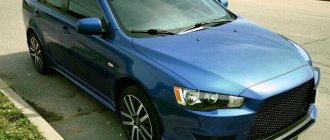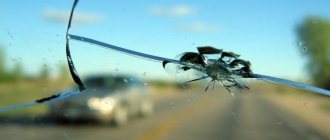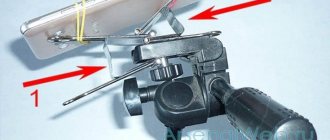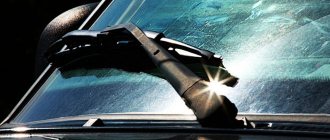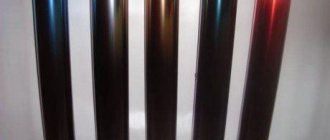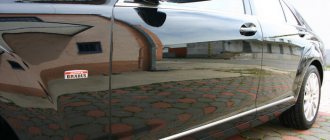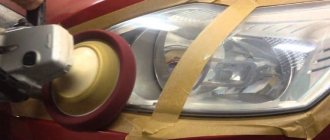History of appearance
Head-up display, like other automotive technologies, originated from aviation. Many years ago, pilots were able to view data not from the instruments themselves, but from a transparent screen. In fact, this innovation can be considered outdated, although until recently it was not particularly popular.
The projection for the car was installed for the first time in 1988. This was done by General Motors. Then the screen was black and white, it became color 10 years later.
In 2003, the German company BMW tried a similar technology. Innovative equipment was then available only to owners of premium cars. Over time, BMW began to introduce projection into budget models. Buyers were offered to install the display as an additional feature. Today, the market offers consumers different options for creating a projection.
What is a car windshield projector?
The first HUDs displayed only a small amount of information and were inconvenient to use. At first, the projected display became monochrome. Then - in color. At first, the projector was installed only in premium cars. Now it’s the turn of budget models. Modern projection systems can fill half the glass, helping the driver see the surroundings, car signs, pedestrian crossings, and much more.
The projector unit receives information from the OBD diagnostic connector, processes it, and sends it to the reflective film of the windshield or retractable screen. Both options are offered as standard.
All data from the diagnostic connector can be displayed on the screen. Even readings from individual sensors. Navigators will help you “consider” road signs and driving routes.
Further development of HUD involves analysis of the surrounding road situation, pedestrian movement, acceleration of objects, and interaction with road infrastructure.
How it works
The Head-up Display system, translated from English, literally means “display for a raised head.” By design, it consists of only two parts: the projector itself and the film. The image is projected onto the latter. The projector receives data either from a satellite or from an on-board computer. Today, you can install such equipment in any car; you just need to purchase it.
The principle of operation is quite simple. First, the electronic unit receives information from the OBD (on-board diagnostics) unit, processes it and sends the image to the reflective sheet. The picture appears either on a transparent retractable display or on the windshield.
Some types of HUD systems are complemented by light and sound sensors that warn the driver of various problems (for example, a drop in engine speed).
After drivers began to en masse install a projection system on the car windshield, ersatz began to appear on the market. They are gadgets that perform the same functions by connecting to the car's electronics.
Mobile developers, in turn, began creating applications. After downloading the program, the driver will be able to install the phone above the dashboard and receive the coveted projection. Unfortunately, the picture transmitted by smartphones is of very poor quality and disappears in sunlight.
Types of Head-Up Displays
Depending on the installation method and design features, there are three main types of projection displays for cars:
- regular;
- projection;
- mobile.
The standard HUD is an additional option that is “purchased” when purchasing a car. As a rule, the device is installed above the instrument panel, and the driver can independently change the position of the projection on the windshield. The number of displayed parameters depends on the technical equipment of the vehicle. Mid- and premium-segment cars signal about road signs, speed limits on roads, and even pedestrians. The main disadvantage is the high cost of the system.
A head-up HUD is a popular type of handheld device for displaying parameters on the windshield. Key advantages include the ability to move the projector, ease of self-setup and connection, variety of devices and their availability.
Popular Garmin Head-Up Display
Projection HUDs are significantly inferior to standard systems in terms of the number of displayed parameters.
Mobile HUD is an easy to use and easy to set up portable projector. It can be installed in any suitable location and the quality of display parameters can be adjusted. To receive data, you must connect the device to your mobile phone using a wireless network or USB cable. All information is transferred to the windshield from the mobile phone, so additional software must be installed. Disadvantages include a limited number of indicators and poor image quality.
The principle of projecting data from a mobile phone
Projecting information about the vehicle and driving mode onto the windshield is not an essential function. But the technical solution greatly simplifies the driving process and allows the driver to focus exclusively on the road.
Types of projectors
Having learned what a projection on the car window is for, drivers begin to look for suitable equipment.
All types of projectors are divided into several types:
Classic is a device with a small body that is installed in most vehicles. The device projects information in detail, which is why it is preferred by all experienced drivers. However, the lack of light intensity adjustment makes some people look towards other devices.
Multimedia - a model additionally equipped with a sound sensor. In addition, the user has the ability to adjust the display brightness, speed indicators and alert volume.
A projector-navigator is a device with large dimensions and a high price. Using a multifunctional HUD display, information is transmitted to the windshield. The GPS module receives data from satellites. After processing, they are displayed in front of the driver.
A device with a built-in recorder is a model with a camera that records video while driving. In the event of a sudden accident, the driver will be able to remove the media and review the recording.
Judging by numerous reviews, drivers trust brands such as Rivitek, Garmin, Samsung, Nec and Atdiag. As a temporary option, you can use a smartphone.
Types of Projectors
Currently, there are various options for HUD projectors on the market, which can be separately divided into several specific types with characteristic pros and cons, namely:
- HUD projectors with built-in navigation;
- devices including a video recorder;
- classic and least expensive devices;
- multimedia HUD projectors.
In this case, the car enthusiast must take into account the fact that all devices differ in size, types of fastening, as well as options for connecting the device to the on-board network.
Basically, in recent times, multimedia devices have had the advantage, for the simple reason that in addition to being informative, these devices have a wide range of settings. Also, when using such a system, a sound signal is provided, which is extremely useful on long trips, when the driver’s attention gradually becomes dull. As for the classic options, these are the most compact and easy-to-use HUD projectors. Devices with a DVR can be called the most expensive, and projectors with navigation also imply large dimensions and a relatively high cost. The most popular devices are from ASUS, Garmin and Rivitek. If a car enthusiast is looking for only a temporary solution, then in this situation even a regular smartphone with the appropriate software will suit him.
Output information
All HUD systems on the market display vehicle speed data. By connecting to the speedometer, they display the instrument readings again, or display the speed, calculating it through the navigation system.
In addition to the speed, tachometer readings are duplicated on the windshield. As additional information, data on the gear in which the car is moving can be provided.
Some devices are equipped with a parking sensor connection function. In this case, information about obstacles around the vehicle is displayed on the glass.
The most expensive models have the ability to display navigation. The car enthusiast will not have to constantly look at the navigator, because... the movement map will be before your eyes.
What information is displayed?
Let's take a closer look at what information this technology displays:
- Most often, drivers want to see a speed projection on the car windshield;
- Also, information about engine speed can be displayed there;
- Readings of various instruments from the dashboard;
- Coolant temperature;
- Remaining gasoline;
- Information about faults and lights on the dashboard;
- Hints with deciphering road signs;
- Navigation;
- Information about the operation of the audio system;
- Display of blind spots from mirrors;
- Cruise control settings;
- Video from rear view camera;
- Presence of pedestrians
- Etc. (in fact, information from any sensor of the control unit can be displayed there).
Advantages and disadvantages
Having learned what it is and how the projection on the car window works, drivers increasingly began to purchase modern projectors.
The main advantages of the devices are as follows:
Now you don’t need to be distracted from the road, all the necessary information is displayed on the glass.
Installing the projector is not difficult, and it does not take up much space in the cabin.
The device can be used by everyone, regardless of region of residence and climate.
Before installing the device, it is recommended to stick a special film on the glass. It refracts the rays, which means the detail will become even clearer.
The disadvantages of projectors include:
Overpriced models equipped with a camera and GPS module.
When connecting the device to the cigarette lighter, a lot of unnecessary wires appear in the cabin.
When cracks or dirt appear on the glass, detail deteriorates significantly.
By connecting the projector, the driver not only creates a comfortable driving experience, but also increases road safety.
How to make a projection on glass using a mobile application?
We just have to look at the last type of windshield projection, which does not require the purchase of special projectors or software. The technology works from a regular smartphone with an application installed with hud support. Go to the Play Market or App Store, there are a lot of similar utilities there.
Unfortunately, you can’t make a projection on the windshield with your own hands, as if it came from the factory. The quality of the picture will be noticeably inferior, and the amount of information displayed will not please you with quantity. Most likely, these will include speedometer, odometer, tachometer, and some additional information that can be obtained via GPS or the Internet (latitude, longitude, map, weather, time, traffic jams, etc.).
By the way, if you want to achieve the highest quality image, even on a sunny day, buy a separate sticker for hud projection, it costs no more than 100 rubles.
How to make a universal projection on the windshield via a smartphone with a GPS module?
- Download a mobile application, for example, “Speedometer 55 Start. GPS+Hud" (for IOS);
- Place a special sticker on the glass (optional);
- Open the app and place your phone on the dashboard;
- Activate the Hud option in the application;
- Move your smartphone so that the projection on the windshield coincides with the area on which the sticker is pasted;
- Done, you can go.
This concludes our review. Laser projection onto a car windshield today has many supporters and opponents. Everyone has their own truth. However, this technology definitely has a great future. Moreover, it is connected with the introduction of an augmented reality system! That is, smart technology will analyze the situation outside (for example, at night) and recognize its elements - invisible pedestrians, road signs hidden by foliage, markings, speed of surrounding vehicles, etc. And all this information will be displayed on the windshield in projection! Isn't it cool?
Varieties
Before choosing a projector for yourself, it would be a good idea to find out what they are like and how they differ from each other. This can significantly affect the final decision, so there is no need to rush in this matter.
Almost any technology begins to develop and improve from the moment it appears. The first prototypes and working samples of windshield projectors were not ideal. Manufacturers had something to work on and something to improve.
As a result, updated versions, improved and modernized displays began to appear. Now everyone has the opportunity to purchase a projector that has a universal design and is suitable for many models and brands of cars. It is not necessary to buy a car from leading automakers in the most expensive trim levels. From now on, projectors are available to everyone.
The only question is which of the huge number of car projectors to choose for yourself. To answer this, you need to understand the current assortment.
Based on the method of connection to the vehicle, car projectors are classified as follows:
- through the cigarette lighter. This is the simplest option for connecting a HUD display. But at the same time, it is also the least informative for the driver. Displays basic information on the windshield. Easy to use, versatile and easy to connect. Even if the car is under warranty, the seller will not have any questions or complaints in connection with connecting the display through the cigarette lighter;
- using the diagnostic port. A fairly popular option, which in most cases allows you to make the connection yourself. Such models are usually more functional and offer various capabilities and operating modes. Reading information from the vehicle through the diagnostic port, it is displayed on the windshield;
- through the on-board system. Here a direct connection to the vehicle's on-board system is made. Such a connection makes it possible to combine a large number of sensors, information from which will be displayed on the windshield display. But it is not recommended to connect such equipment yourself. It is better to entrust the work to specialists so that the projector fully justifies the investment in it.
Devices are also classified according to their functionality. There are 3 main categories of projectors.
- Multimedia systems. Currently considered the newest and most advanced projectors. Their advantage is that such devices are capable of fully displaying information. But at the same time, they accompany their work with sound alerts. When the system notices that some parameter does not correspond to the norm, the equipment informs the driver about this. Thus, the motorist always knows if something is wrong with the car and appropriate measures need to be taken.
- Speed projectors. The simplest devices that are capable of displaying a minimum of useful information. They show the current speed of the vehicle on the windshield. But they are complemented by a sound warning system if the driver exceeds the speed limit. The connection is made to the on-board computer. There are improved versions of such projectors, where the speed information is supplemented with other functions. Such devices are capable of reporting the voltage in the on-board network, the temperature of the coolant, as well as the current state of the side lights (on or off). There is another subcategory where it is worth noting the presence of a built-in GPS antenna and the ability to connect via a Bluetooth port.
- Navigation projectors. Functionally, these projectors can also display speed information, data from the tachometer and other sensors on the windshield. But what distinguishes them from the rest is the presence of a built-in navigator. That is, an image with maps and the direction of movement is displayed on the windshield. Additionally, some models can play music and display photo and video files.
As for manufacturers, there are several of the most popular companies whose products are trusted by consumers.
The following brands appear in a kind of rating among manufacturers of projectors for windshields of vehicles:
- Samsung;
- Asus;
- Garmin;
- Carax;
- Toshiba;
- Nec.
The driver should decide what functions he wants to get from the installed projector, and how important additional features are to him. The more functions a projector has, the more expensive the purchase and installation itself will be. And overpaying for something that the driver will not use is not entirely reasonable.
Focus on quality and efficiency. Therefore, in this regard, it is better to choose devices with truly useful capabilities and parameters that are relevant when driving a vehicle. Moreover, it is better to trust trusted manufacturers who have proven themselves well in this segment of automotive devices.
What it is
If we literally translate the concept of HUD, which we perceive as a windshield projector, then this means a raised head display. That is, a person, without lowering or turning his head, can receive the information he needs directly from the windshield.
Experts have proven that a projector installed in a car has a positive effect on safety, reduces accidents, and ensures greater driver concentration on the road. This objectively benefited motorists, since it was possible to minimize the need to be distracted by the dashboard or center console in order to read this or that information. Everything is before your eyes. At the same time, modern displays allow you to customize and select what exactly will be displayed on the glass.
Similar developments were actively introduced into automobile production. Today there is an extensive list of different systems and advanced displays. They allow you to display the following information on the glass:
- tachometer indicators;
- speedometer data;
- cruise control information;
- lateral overloads;
- operation of head optics;
- coolant temperature;
- number of kilometers traveled;
- current fuel consumption;
- amount of remaining fuel;
- navigation information;
- data from an infrared night vision camera, etc.
The device includes a high-brightness LED display and special mounts. With their help, the device is installed on the dashboard, and then projects information onto the inner surface of the car’s windshield.
Additionally, the package includes a special film made of thin material. It is mounted on the windshield itself and allows you to receive information from the projector.
HUD displays were initially only available in expensive cars and top trim levels. Nowadays, a number of companies produce similar projectors. Car gadget manufacturers offer a wide range of projectors. Among them there are both simple models with minimal functionality, and devices with high capabilities and a wide range of displayed information. At the same time, their cost is quite acceptable and adequate, which allows fans of tuning and technical innovations to install a projector even on their relatively inexpensive car.
Speedometer projector on glass: everything you wanted to know, but were embarrassed to ask...
Hello comrades!
Minsk time is 9 o’clock, in Petropavlovsko-Kamchatsky it is midnight.
I am starting a program based on your requests and today you will learn how to easily and at no extra cost: - make a portable shaker from a “Vyatka” washing machine; — organize a home weather station from a rectal thermometer and AA batteries; - with the help of a plastic bottle, a lighter and grandma’s herbarium, create a good mood for a large company... Maestro, shorten the march! We will talk about fuel economy, high-speed radars and car tuning “a la Russe”!
Who is too lazy to read - IMMEDIATELY! Background and motives for purchase
I am a very frugal person. Yes, these are exactly my exclamations : “Who didn’t turn off the light in the kitchen behind them!!?”
you can hear it even in the vestibule.
It’s on my balcony that the washed used bags proudly develop. You’ll see me on the beach in boiled dumplings cut off to fit shorts and carefully placed by my mother. So who am I after this? Sucker? No, this is the wrong answer. I am the beloved Husband and Folder of level 80. Because there is no extra money in the family! Never. Until we... until we... “bought a ticket to Turkey and a second fur coat,” thank you, dear, for the tip! If you have not yet closed the tab of this review in honor of the review of the next power bank, then you have fallen into my zombie trap and, at a minimum, will read the article to the end. At the very least, sign your apartment and car over to me. We’ll talk about it (the car) today. My family has two cars. One, an almost new Peugeot, is in the use of my wife, and the second, a ninth-generation Mitsubishi Lancer Wagon born in 2006, is in my possession. The first one was bought to transport the entire family (me, my wife, two children) and is equipped with all the newfangled bells and whistles from climate control to cruising. The second is a kind of “stepson” and was born for humiliation by moving formwork/blocks/cement/surrounding rubbish in space. It looks unsightly, like a trampled slipper, but 95% of trips take place in it. It just so happened that my Lancer IX is not equipped with an on-board computer. Of course, it is there, but there is no display with readings. For this reason, I don't even suspect about fuel consumption. And this, damn, how inconvenient! I also regularly catch high-speed radars on the highway, which also cost a pretty penny... Due to the fact that my faithful Mitsubishi Lancer IX is not equipped with an on-board computer (for those who don’t read spoilers), and there is no way to exchange the car for a more expensive one neither desire nor opportunity (read above), I decided to buy a HUD, aka an on-board computer projector on the windshield. And now I can already hear the objection of User AlekseyM (August 18, 2013, 09:09)
“For those who just want to “try”, buy a Bluetooth obd2 adapter - cheap and cheerful.
On a phone with an adapter, a program like hob drive, CoroO is installed and everything you are interested in looks on it, if you like it, you can already install such a thing. Well, that's what I did. The first step was the purchase of a primitive OBD scanner, which transmits on-board computer data to the phone via Bluetooth. I really liked the idea, but not the implementation. Firstly, to activate you need to use TWO devices - a scanner and a phone. In addition to the fact that you first need to install the phone on a tripod, turn on Bluetooth and launch the appropriate program (I had Torque lite), you also need to regularly check the battery condition. In the active Torque lite mode, the battery in the phone is drained to zero in 3 hours. The conclusion from this is that this option does not suit me. After studying Musya, I came across this review about the HEAD UP display by user blackhyu (August 18, 2013, 3:46 pm) “I’ve been using a similar one for 2 years now on the Hyundai Tucson.
Very satisfied. Only he placed it not in the center of the torpedo, but on the left. It’s not so noticeable and doesn’t bother you. And mirror film also doesn’t look so “strange” from the street. Plus, I put a black plate on the glass in the corner - from the street you can’t see any kind of box at all. I only look at readings using this type of device. In general, I’m 100% satisfied” after which the conclusion was made unequivocally -
we must take it!
Which HUD should you choose?
This question can be answered by determining the range of necessary functional requirements.
In my case, these are: - A bright, easily readable display; — Large font of indications for ease of perception; — Information about speed and fuel consumption. Where possible, this should be accompanied by intelligent notifications of significant changes in on-board computer readings. Based on my preferences, 2 models fell into my field of interest: 1. The popular HEAD UP DISPLAY F01
, which is sold on BUYSKU.COM for
$68
and was repeatedly reviewed on my favorite MYSKU.
2. “Dark horse” due to the innovation of the product (2014 model) HEAD UP DISPLAY ASH-4,
which I FIRST found on the ALIEXPRESS.COM website for
$49
The first option immediately fell out of favor due to its small size and pale green backlight. And the price... I liked the second option due to its larger 5.5-inch size and the ability to choose the projected color: moonlight white, yellow and blue.
And so I practically raised my finger over the
“PAY”
, but... I thought, shouldn’t I look cheaper on other sites.
I did the opposite and found a fat coupon for a %8 discount off $40 at eachbuyer.com. In the end, it turned out cheaper than on ALI (!) for only $46
, and they also accept PAL. I contacted the seller to check availability. They answered immediately - yes, there is. If, they say, we see a baby, we will send it within 48 hours. That's what we decided. The goods lasted for about a month, which is a good indicator for the New Year.
So what did I order?
Specification in English
Features: — Standard OBDII interface, easy to install and operate. — Adopts high brightness projection technology. Automatically sense the display brightness to ensure the clear projection on car windshield. — Information display is simple and clear to improve road safety. — 5.5 inch large display, easy to read. Screen flickering alarm. — Suitable for any vehicles conformed to OBD II, which are manufactured after 2007. HUD is short for Head Up Display. It is dangerous if driver watches the dashboard while driving on expressway, especially at nights. If there is any emergency situation ahead, it might be too late to take effective actions and then accidents might happen. To avoid this situation, we recommend you to install a HUD Head Up Display. This product can project important information (eg vehicle speed) onto the front windshield at the eye level of the driver. It is helpful to reduce accidents due to head-lowering while driving. It is developed based on OBDII interface. The installation is very easy. Please read the details of user guide carefully before use. Color: black Material: ABS Package size: approx. 17 x 13 x 4.5 cm Display size: approx. 147.5 x 85 x 14 mm OBD cable length: 1.44m Interface: 16pin Working voltage: 9-16V Functions: 1. Displays the vehicle speed, engine speed, water temperature (voltage / throttle position / ignition advance angle / 100km acceleration time), instant fuel consumption, average fuel consumption, mileage, low fuel indication, rest tips, and engine failure. 2. Display modes: normal, high-speed, or automatic (optional) 3. Units can be freely switched between kilometers and miles. 4. 5.5″ large screen, easy to read 5. Auto switch on/off. It starts or shuts down along with the vehicle, effectively protecting the vehicle battery. It can also be turned on/off manually. 6. Single stage or fourth stage of alarm modes can be chosen, ensuring traffic safety. 7. With revolving speed alarm reminding driver to change the gear to save fuel consumption. 8. Brightness can be adjusted manually or automatically. 1 x OBD (with connection cable) 1 x Display 1 x English user guide 1 x Reflective film 1 x Anti-slip pad In original package
Specification in Russian (my translation)
Peculiarities
: — Standard OBDII interface;
— Application of high brightness design technologies; — Contrasting and clear image on the glass to facilitate perception and increase road safety; — 5.5 inch screen makes it easy to read; - Universal for any vehicle equipped with an OBD II connector that were manufactured after 2007. Color: Black Material: ABS Package Size: 170 x 130 x 45 mm Unit Size: 14.75 x 85 x 14 mm OBD Cable Length: 1.44 m Interface: 16pin Operating voltage: 9-16V Functions
: 1. Shows vehicle speed, engine speed, coolant temperature (voltage/throttle position/pre-ignition angle/100km acceleration time), instantaneous fuel consumption, average fuel consumption, mileage, fuel level, rest time prompts and engine errors;
2. Monitor operating modes: normal, high-speed, or automatic (optional); 3. Selection of units of measurement: kilometers and miles; 4. 5.5-inch large screen; 5. Automatic switching on and off with vehicle starting or shutting down. There is also a manual activation function; 6 Flexible Driving Safety Warning System: Four-stage alarm system will help you control the safe speed level. 7 Engine speed alarm. This helps to change gear in time to save fuel, also important for a new driver. 8. Three-stage brightness level selection Kit
: 1 x OBD (with communication cable) 1 x Display 1 x User Manual (English) 1 x Glass film 1 x Anti-slip base In the original package
What did I receive? (*Knowing that there would be a shoot for a popular site, several sexy models agreed to assist me: blondes, brunettes, redheads and even mulattoes...
) I received a small envelope wrapped in polyethylene foam. The size of the box is comparable to a navigator. Full set inside. The HUD is packaged in a full-fledged “sold and given away” package.
There is nothing to say about the anti-slip mat and film - film and mat. Everything is packed in bags. Instruction manual in English. The link to it is here. A cable with an OBDII chip (side connection) on one end and a mini USB on the other. The cord length is 1.5 meters, which is enough for almost any car. The cord is flat and elastic.
Now about the projector
. The dimensions and weight of the device correspond to those indicated on the website. Made of matte black plastic. The body has rounded edges and is fastened with six screws. In the manner of a tablet, I checked for backlashes and squeaks - there are none. The front side is covered with a matte film with the corresponding sectors of indicators in yellow and gray. All symbols are mirrored. There is a speaker on the back of the projector. At the top there is a scroll button that works in three directions: right, left and press. The button travel is soft and springy, the rib is ribbed. At the bottom end there is a socket for a cable in miniUSB format. In general, the device is very ascetic, so a lengthy story does not work out. Images will be more telling.
Installing the device on a car
1. The device is compatible with any car that supports the OBDII standard. You can find out whether your car supports this standard here or in the technical documentation for the car. 2. To locate the OBDII diagnostic connector, you need to rummage around in the steering column (sometimes under the ashtray or in the armrest) in search of a 16-pin socket. This is where you need to put the HUD chip, obviously, with the engine off;
3. Next, you need to place the device projector on the panel in the intended installation location under the windshield.
If necessary, you can use a rubber mat (included); 4. In the place where the indicators are projected onto the glass, you must stick a mirror film (included), first the glass must be thoroughly cleaned. The film will eliminate doubling of symbols on the windshield. In the mystery of gluing, all the Laws of applying a protective film to the display of a smartphone apply: A. Spray water on the windshield in the place of the sticker and on the film B. Apply the sticker to the glass C. Using a credit card, expel the moisture from under the film from the center to the edges; 5. The cable, if desired, can be tucked under the trim or interior seal. 6. We use it. This is PLUG-N-PLAY! The entire installation process is described in detail in this
review, thanks to comrade.
He1ix
.
Functions of the control button.
1. Configure device settings and notifications.
When the car is started, you need to press the button in the central position and hold it for 5 seconds. Function zone A and B will light up and go into standby mode. This means it will be possible to change the parameters in accordance with the Table in the Manual.
To set the necessary parameters, you need to turn the slider left or right.
You can move through the parameter sectors by briefly pressing the slider in the central position. To exit the settings menu, press the button in the central position and hold for 5 seconds. 2. Setting up a sound notification.
When the car is started, you must hold the button in the extreme left position for about 3 seconds.
A speaker icon appears on the display. This means that a buzzer sound is added to the notification indication. You can remove the sound notification by repeating this procedure. 3. Setting up dynamic indicators (displayed while moving)
. When the car is started, you must hold the button in the extreme right position for about 3 seconds.
You will enter the menu of dynamic parameters 1, 2 and 3. By pressing once you can select the parameters of the dynamic menu required to be displayed.
Now regarding the information display of the device.
Below is a schematic representation of the ASH-4 projector broken down into information sectors.
1. The interactive display
is mainly designed to display the vehicle speed.
It can be expressed in kilometers and miles. If desired, you can set the speed mode and only the speedometer readings, fuel consumption and one of the indicators in paragraph 16 will be displayed 2. Information board, housing 3. Low fuel level indicator
I have it set in automatic mode.
Lights up when there are about 10 liters of fuel in the tank. On the device it works a little later than on the scoreboard. The error is 4-6 kilometers. You can set the desired fuel level for the sensor to trigger. 4. Error indicator /check/.
God forbid, of course...
5. Tachometer.
Duplicates the readings of the standard tachometer.
The scale lights up constantly, and with an increase/decrease in engine speed, the corresponding numbers on the scale light up (more clearly in the video) 6. Decoding the tachometer readings.
Traditionally, we multiply the figure by 1000, measured in
revolutions per minute 7. Indicator of exceeding the set speed.
The function is activated depending on your presets.
Can be configured to trigger when crossing 4 speed thresholds at the same time: 60,80,100,120 km. If desired, you can set it to trigger once when a certain speed threshold is crossed. My speed is 102 km/h because... Our radars are said to be configured to take photographs at +12 km from the established speed limit. It seemed like it was still flying by... 8. Indicator of exceeding travel time.
It will light up if more than 4 hours have passed since the start.
As someone who has woken up in oncoming traffic, I don’t recommend joking with this! 9. Sound notification indicator about significant changes in on-board computer readings.
It works like a buzzer together with indicators 3,4,7,8,9.
10. Fuel consumption indicator.
Probably needed for beauty.
Means that the readings to the left of it relate to fuel consumption... 11. Fuel consumption readings.
Quantitative expression of fuel consumption.
Calculated in liters. 12. Device control button
Navigation button, described in detail above.
13. Fuel consumption indicator:
XX liters per 1 hour.
Judging by the level of the numbers, it fits the description “Average fuel consumption sensor” 14. Light sensor.
Works when the automatic backlight brightness function is activated.
15. Fuel consumption indicator:
XX liters per 100 km
16. Indicators: — On-board network voltage.
In my case, the voltage range is from 13.2V to 14.5V, depending on the operating mode of the car.
Recently the spark plugs flooded and the car did not start the first time. I clearly saw how the voltage after each attempt to start it dropped before my eyes from 14 to 11 V. - Throttle position.
In other words, the intensity of our pressure on the gas accelerator and how the throttle control unit understands this.
A utilitarian, but not a secondary function, is a uniform idling of the engine. Experts say that for my engine this unit is at risk, so this is a very useful indicator. — Coolant temperature.
A very useful and VISUAL indicator.
When starting the engine it now shows 0 degrees. As it warms up, the indicator increases and only at 40-45 degrees does the standard arrow on the panel wake up. I start at 50-60 degrees. — Ignition timing.
This indicator should not exceed 10 degrees.
Otherwise, increased fuel consumption is inevitable. — Acceleration.
This function is used to calculate the acceleration index.
In other words, the intensity of movement of a car in space over a certain period of time. Damn, my wife is right, I ALWAYS COMPLICATE EVERYTHING! Oh that's it, let's move on... 17. Seconds indicator.
Needed when you measure the acceleration of a car, i.e.
time in seconds and hundredths for which you will reach 100 km/h. This is for racers... 18. Indications
Indicators 16
19. Kilometer indicator
Lights up when there is only 100 km of fuel left.
I don’t understand why it is needed if there is item 3. 20. RPM indicator (Revolutions Per Minute)
Revolutions per minute.
I get it, this is a detailed tachometer. 21 and 22. Kilometers per hour and miles per hour display indicator
. You can choose in which units the speed of movement will be expressed. Now that the settings are configured, it’s time to test the device on the go.
Now let's go for a drive!!!
We start the car. After 5-7 seconds, the display activates and shows the on-board voltage. The coolant temperature sensor immediately wakes up. During the period when the vehicle speed is “0”, the fuel consumption indicator switches from the XX liters per 100 km indicator to the XX liters per hour indicator. This is logical because if the first function is active, the sky-high consumption will be displayed - 99 liters. As soon as the car starts moving, the consumption indicator of XX liters per hour automatically switches to the consumption indicator of XX liters per 100 km (visually in the video). If while driving the parameters of the standard display slightly differ from the HUDa data, you need to make fine adjustments in accordance with the Table in the Instructions. How do you read fuel consumption parameters in a car? On one respected forum I found an answer that satisfied me: multiply the pulse duration of the injectors by the pressure in the line and multiply by the performance of the injectors. There are, of course, weaknesses in this formula, such as contamination of the injectors, fuel quality, condition and size of tires... All this is not taken into account by the on-board computer. However, what is important for me is not so much the exact amount of fuel consumed in liters, but the increase and decrease in consumption depending on driving style. If you are not satisfied with the calculation formula I gave, welcome to the spoiler. I warn you, the data can cause a nervous tic and a deep-seated inferiority complex.
READY? STADY! GOW!!!
Q=100Gt/(Vaρt)
, where Gt is the hourly fuel consumption, kg/h;
Va—vehicle speed, km/h; ρт—fuel density, g/cm3. To calculate hourly fuel consumption, it is necessary to multiply specific fuel consumption by power: Gt = geNe = 0.03VhnPe/(Hнηe)
, where ge is specific fuel consumption, kg/(kWh);
Ne—effective engine power, kW; Pe—mean effective pressure, kPa; Nn—lower heat of combustion of fuel, kJ/kg; ηе - effective efficiency; Vh is the working volume of the engine cylinders, l; n — crankshaft rotation speed, min-1. The crankshaft rotation speed is determined by the formula through the vehicle speed: n=2.65*io*iк*Va/rк, where io, ik are the gear ratios of the main gear and gearbox, rk is the rolling radius, m. The effective efficiency of the engine can be express through mechanical and indicator efficiency as follows: ηе = ηmηi = Peηi/(Pe+Pп)
, where Рп is the average pressure of mechanical losses in the engine, kPa.
The average effective pressure Pe is determined from the equation of power supplied to the wheels of the car. The power at the drive wheels is equal to the sum of three terms: (Gаψ+0.077kFV2a±0.1βGaVa)Vа/3.6*103. The third term is the additional force Pj to overcome inertial forces. This force is the sum of the force Pp necessary to accelerate the translationally moving masses, and the force necessary to accelerate the rotating parts. For simplified calculations, we can assume that the force Pj is disproportionate to the force Pp and the coefficient β, which takes into account the influence of rotating masses (flywheel, wheels, etc.): Pj=βРр≈ 0.1βGaVa
, where Va is the acceleration (deceleration) of a moving car, m /s2.
Coefficient β is approximately calculated using the formula β=l+aKi2k
, where ak is a constant value for a given vehicle (for cars 0.03...0.05, for trucks and buses 0.05...0.07);
ik is the gear ratio in the gearbox. Thus, Neηtr = VhPenηtr/120 = (Gaψ+0.077kFV2a±0.1βGaVa)Vа/3.6*103.
Hence, kPa, Re=12.56rк(Gaψ+0.077kFV2a±0.1βGaVa)/(Vhi0ikηtr).
To determine the average pressure of mechanical friction losses in an engine, there are a number of empirical formulas, which are generally written as Рп=а+bСп, where a and b are constant coefficients for a given engine; Sp—average piston speed, m/s. These losses are practically independent of engine power. Expressing the piston speed through its stroke (Sp, m) and the crankshaft rotation speed (n, min-1), we obtain, kPa, Рп=а+0.033b*Sn*n
.
Approximately 65% of energy losses due to friction occur in the cylinder-piston group, 15 - 20% - in gas exchange processes and 10% - in the drive of auxiliary devices. By reducing mechanical losses due to friction, gas exchange and the drive of auxiliary devices, fuel consumption can be reduced by 3 - 5%. Coefficients a and b are experimentally found for each type of engine at different ratios of the piston stroke Sp to the cylinder diameter Dc. For carburetor engines at Sp/Dt1, the value of coefficients a and b is slightly greater than for Sp/Dt. For diesel engines, coefficients a and b are slightly greater than for carburetor engines. With sufficient approximation for practical calculations, a for diesel engines can be taken as 48 kPa and carburetor engines as 45 kPa, b - 16 and 13 kPa*s*m-1, respectively. Sometimes the instantaneous consumption figures are downright scary and your foot involuntarily loosens the pressure on the gas pedal (especially when starting from a traffic light). For this reason, I noticed some changes in my riding style. I cannot confirm the objectivity of the recorded consumption because there is nothing to compare with. At the end of the route, after turning off the engine, the display shows the average consumption for the trip. This seems to be true. For me it was 9-9.3 in the city, outside - about 7.5 liters. In motion, the parameters are perfectly readable both at night and during the day. After one or two days of use, I completely stopped looking at the standard speedometer. This is logical: it is much easier to look away a couple of centimeters horizontally than to look for numbers in the loophole through the steering wheel. Moreover, the standard panel of the Lancer, in the general opinion of the owners, is rather dull. I set the brightness of the device to AUTO mode, which works fine. For the perfectionists, I’ll report - the numbers on the windshield are not visible from the outside, no one will point a finger. The only thing visible from the outside is the mirror film on the glass. In the evening, a light spot is visible where the HUD is installed.
Well, it's time to wrap things up and move on to dessert. As a result of this purchase, I:
- received objective VISUAL information about the on-board computer readings - speed, fuel consumption, coolant temperature, on-board network voltage, etc. — warned the family budget against unnecessary costs for fuel and traffic police fines — reinsured himself against engine errors — upgraded his tarantass. This circumstance may cause indignation among those who fight against blue dimensions and pseudo-direct flow, but... firstly, over the years of contemplating the same type of console you get pretty tired of it. Secondly, every new passenger looks at this function with undisguised interest, which is really nice. Even neighbors in traffic jams are interested in the gadget. Well, this is more for extroverts.
As usual, I add my video
A few more video reviews of the ASH-4, which may shed light on aspects of the device that I have not touched upon.
CRY
Instead of an epilogue:
I wanted to make not so much a laudatory, but rather a detailed review of an unusual device. I hope that the main goal has been achieved and you will get the source code to make a purchasing decision. If the text turned out to be useless to you, then you. For me personally, the subject causes exceptional erotic hyperesthesia and an irrepressible desire to be behind the wheel. In a word, my Savrazka and I are on our second honeymoon. Good to everyone, and Good-natured traffic cops and Good roads to the drivers!



